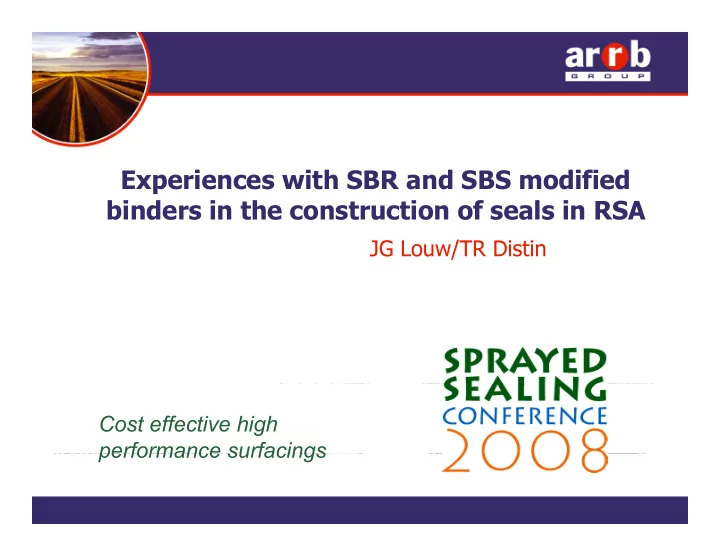

E Experiences with SBR and SBS modified i ith SBR d SBS difi d binders in the construction of seals in RSA JG L JG Louw/TR Distin /TR Di ti Cost effective high performance surfacings performance surfacings
Overview • Use of modified binders in RSA f f • Properties of SBR and SBS modified binders • Storage stability during handling • Storage stability during handling • Application techniques for spray seals • Design of modified binder spray seals Design of modified binder spray seals • Summary www.arrb.com.au 2
Modified bitumen usage in Seals g • < 1982 - mainly SBR and natural latex in anionic emulsions • • 1982 1982 - Bitumen-rubber Bitumen rubber • 1984 - SBR latex in hot bitumen • 1989 - SBR latex in cationic emulsions • 1990 - SBS polymer in hot bitumen penetration 16% cutback 8% 44% em ulsion SBS 20% SBR 2% 10% Rubber www.arrb.com.au 3
SBS block co-polymer Ordered molecular structure SBR (latex) Random molecular structure Random molecular structure = styrene = butadiene www.arrb.com.au 4
Polystyrene domain P l Polystyrene domain t d i Butadiene chains Butadiene chain B Branched SBS h d SBS Linear SBS www.arrb.com.au 5
Softening Point of SBR vs SBS g (80/100 pen base bitumen) 110 100 (deg C) 90 ning Point 80 SBS SBR 70 60 60 Softe 50 40 0 0 1 1 2 2 3 3 4 4 5 5 Polymer content (%m/m) www.arrb.com.au 6
Viscosities – SBR vs SBS (80/100 pen base bitumen) 900 800 700 mPa.s) 3% SBR 600 Viscosity (m 500 400 3% SBS 300 80/100 200 200 V 100 0 130 130 140 140 150 150 160 160 170 170 180 180 190 190 200 200 210 210 Temperature (deg C) www.arrb.com.au 7
Elastic Recovery – SBR vs SBS y (80/100 pen base bitumen) 90 90 deg C (%) 85 80 75 75 overy @ 15 70 3% SBR 65 3% SBS 60 lastic Reco 55 50 45 40 40 El 5 10 15 20 Temperature (deg C) www.arrb.com.au 8
1.60 1 40 1.40 1.20 sion J/cm2 1.00 3% SBR Cohesion 0.80 80/100 Cohes 3% SBS 0.60 properties 0.40 0.20 @ 5 ° C 0.00 10 20 30 35 40 45 50 60 Temperature (deg C) Tensile Properties – NF EN 13587 Tensile Properties NF EN 13587 Initial length = Unit 3% SBR in 3% SBS in 80/100 50 mm 80/100 80/100 At break: At break: Elongation % 339 >900 >900 Stress MPa 0,06 0,59 0,68 Deformation Energy Properties – NF EN 13703 o o gy op s 3 03 At break: Mean energy J/cm 2 9,6 24,1 29,1 www.arrb.com.au 9
Storage Stability at application g y pp temperature Dynamic Viscosity Ring and Ball Softening Point 1200 1200 70 70 60 1000 Viscosity @ 135 & B Soft Point deg C (mPa.s) 50 800 40 (deg C) 600 30 SBR (200 deg C) 400 SBR (200 deg C) SBS (180 deg C) 20 SBS (180 deg C) 200 10 10 R & V 0 0 0 0 5 11 13 16 18 0 5 11 13 16 18 Time after manufacture (hrs) Time after manufacture (hrs) Elastic Recovery 80 70 ecovery g C (%) 60 50 40 40 @ 15 deg Elastic Re 30 SBR (200 deg C) 20 SBS (180 deg C) 10 0 0 5 11 13 16 18 Time after manufacture (hrs) ( ) www.arrb.com.au 10
Typical modified binder seals yp Double Seal Single Seal EXISTING SUBSTRATE EXISTING SUBSTRATE Cape Seal Split Seal EXISTING SUBSTRATE EXISTING SUBSTRATE www.arrb.com.au 11
Typical application rates Single seal 13,2 mm aggregate (ALD = 8,2) Aggregate Spread 5000 1000 > 20000 rate Traffic (ELV) (m 3 /m 2 ) Binder application rate (l/m 2 ) hot Bi d li ti t (l/ 2 ) h t 3% SBR + 80/100 1,65 1,24 1,15 90 – 100 3% SBS + 80/100 1,78 1,34 1,20 90 – 100 Cationic Spray Grade 70% + 1,68 1,27 1,13 90 – 100 5% latex 5% latex www.arrb.com.au 12
Spray rate ajustment factors – TRH 3 p y j SBR modified bitumen Traffic (elv’s) T ffi ( l ’ ) Si Single Seal l S l D Double Seal bl S l S li S Split Seal l < 5000 1,3 1,1 1,2 5000 5000 – 20000 0000 1,2 , 1,0 ,0 1,1 , > 20000 1,1 1,0 1,0 SBS modified bitumen < 5000 1,4 1,2 1,3 5000 – 20000 1,3 1,1 1,2 > 20000 > 20000 1,2 1,2 1,0 1,0 1,1 1,1 www.arrb.com.au 13
Construction of seals www.arrb.com.au 14
Use of cutters • General resistance amongst practitioners • No cutters allowed on National Route contracts • When used with discretion – excellent results When used with discretion excellent results • Generally not more than 4% cutter used • Cutback SBR marginally less temperature sensitive • Cutback SBR marginally less temperature sensitive than SBS PMB’s www.arrb.com.au 15
Semi-priming polymer modified binder p g p y www.arrb.com.au 16
Summary • With the increase in traffic and rapid ageing of the South African national & provincial road network South African national & provincial road network have lead to 70% of all reseals being constructed using modified binders • Practitioners recognise the improved life cycle costs associated with the use of these binders • The improved performance properties of SBS vs Th i d f ti f SBS SBR modified binders have resulted in an increase demand for SBS modified binders www.arrb.com.au 17
Recommend
More recommend